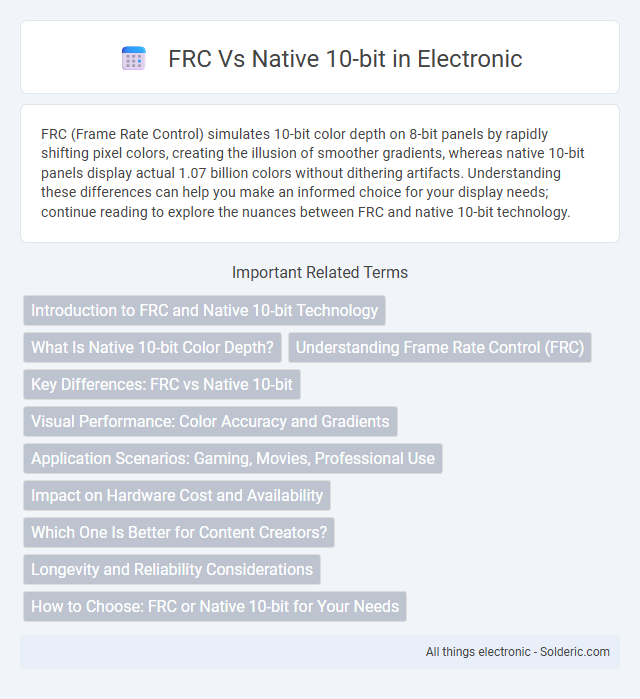FRC (Frame Rate Control) simulates 10-bit color depth on 8-bit panels by rapidly shifting pixel colors, creating the illusion of smoother gradients, whereas native 10-bit panels display actual 1.07 billion colors without dithering artifacts. Understanding these differences can help you make an informed choice for your display needs; continue reading to explore the nuances between FRC and native 10-bit technology.
Comparison Table
| Feature | FRC (Frame Rate Control) | Native 10-bit |
|---|---|---|
| Color Depth | Simulated 10-bit using 8-bit panel + dithering | True 10-bit color without dithering |
| Color Accuracy | Lower, prone to banding artifacts | Higher, smooth gradient transitions |
| Price | More affordable, budget-friendly | Typically more expensive |
| Performance | Uses temporal dithering, may introduce flicker | No flicker, native support |
| Common Usage | Mid-range monitors, budget displays | Professional-grade monitors, color-critical work |
Introduction to FRC and Native 10-bit Technology
FRC (Frame Rate Control) enhances color depth by rapidly switching pixels between shades, simulating 10-bit color on displays originally supporting 8 bits per channel, whereas Native 10-bit panels process true 1,024 shades per channel for more accurate color reproduction. Native 10-bit technology offers smoother gradients and reduces banding artifacts, delivering superior visual quality especially in professional graphic work and HDR content. Your choice between FRC and Native 10-bit affects color precision, with Native 10-bit providing more authentic and consistent color performance for demanding applications.
What Is Native 10-bit Color Depth?
Native 10-bit color depth refers to a display or image processing capability that can render over 1 billion distinct colors (1,073,741,824 to be exact) without relying on software or hardware tricks like Frame Rate Control (FRC). This true 10-bit panel processes and displays color data natively, resulting in smoother gradients and fewer color banding artifacts. Understanding your device's color depth helps optimize visual quality for photo editing, video production, or high-end gaming.
Understanding Frame Rate Control (FRC)
Frame Rate Control (FRC) simulates native 10-bit color depth by rapidly toggling between different shades to create the illusion of intermediate colors, enhancing your display's color range without true 10-bit hardware. Native 10-bit panels process 1.07 billion colors directly, offering smoother gradients and less banding compared to FRC's approximate method. Understanding FRC helps you evaluate whether a monitor's color performance aligns with your professional or entertainment needs.
Key Differences: FRC vs Native 10-bit
FRC (Frame Rate Control) simulates 10-bit color depth by rapidly alternating between shades to approximate more colors, while native 10-bit displays physically reproduce over 1 billion colors through true color-depth processing. Native 10-bit ensures smoother gradients and reduces color banding better than FRC, which may introduce slight flickering or artifacts under certain conditions. Choosing a native 10-bit panel enhances your visual experience with more accurate and consistent color representation compared to FRC technology.
Visual Performance: Color Accuracy and Gradients
FRC (Frame Rate Control) simulates 10-bit color depth by rapidly switching pixels between shades to produce additional colors, often resulting in banding artifacts and less smooth gradients compared to native 10-bit panels. Native 10-bit displays feature true hardware support for over 1 billion color shades, delivering superior color accuracy and seamless gradient transitions essential for professional photo and video editing. The enhanced precision in native 10-bit panels reduces color banding and improves visual fidelity, providing a more accurate and immersive viewing experience.
Application Scenarios: Gaming, Movies, Professional Use
FRC (Frame Rate Control) simulates 10-bit color depth on displays technically limited to 8-bit panels, offering smoother gradients ideal for gaming and casual movie watching where budget constraints exist. Native 10-bit panels provide true 10-bit color accuracy preferred in professional use such as photo and video editing, ensuring precise color representation and reduced banding. For cinematic viewing, native 10-bit displays enhance visual experience with richer color depth, while FRC remains a cost-effective alternative for general entertainment.
Impact on Hardware Cost and Availability
FRC (Frame Rate Control) panels typically reduce hardware costs by using 8-bit panels with simulated 10-bit color depth, making them more affordable and widely available compared to native 10-bit displays, which require more advanced manufacturing processes and higher-quality silicon. Your choice between FRC and native 10-bit impacts both purchase price and the range of available products, with native 10-bit panels often reserved for professional-grade monitors where precise color accuracy is critical. The trade-off directly affects hardware investment and accessibility, especially for users needing high color fidelity without incurring premium costs.
Which One Is Better for Content Creators?
Native 10-bit panels offer true color depth by displaying 1.07 billion colors, providing more accurate and consistent visuals essential for professional content creators. FRC (Frame Rate Control) simulates 10-bit color by rapidly switching between shades, which can introduce artifacts and less precise color representation, making it less ideal for tasks requiring color accuracy. For your content creation workflow, investing in a native 10-bit display ensures better color fidelity, crucial for editing videos, photos, and graphic design.
Longevity and Reliability Considerations
Native 10-bit displays offer superior longevity and reliability due to direct bit-depth processing, minimizing color banding and reducing stress on the panel's hardware. FRC (Frame Rate Control) simulates 10-bit color by rapidly toggling between shades, which can accelerate wear on the display components and potentially shorten its lifespan. When selecting a monitor for professional use, Your choice of native 10-bit panels ensures more consistent image quality and better long-term durability.
How to Choose: FRC or Native 10-bit for Your Needs
Choosing between FRC and Native 10-bit depends on your requirements for color accuracy and budget constraints. Native 10-bit panels provide true color depth with smoother gradients, ideal for professional photo and video editing, while FRC simulates 10-bit color at a lower cost, suitable for general multimedia use. Consider your need for precise color reproduction versus affordability to determine the best fit for your display needs.
FRC vs Native 10-bit Infographic

 solderic.com
solderic.com